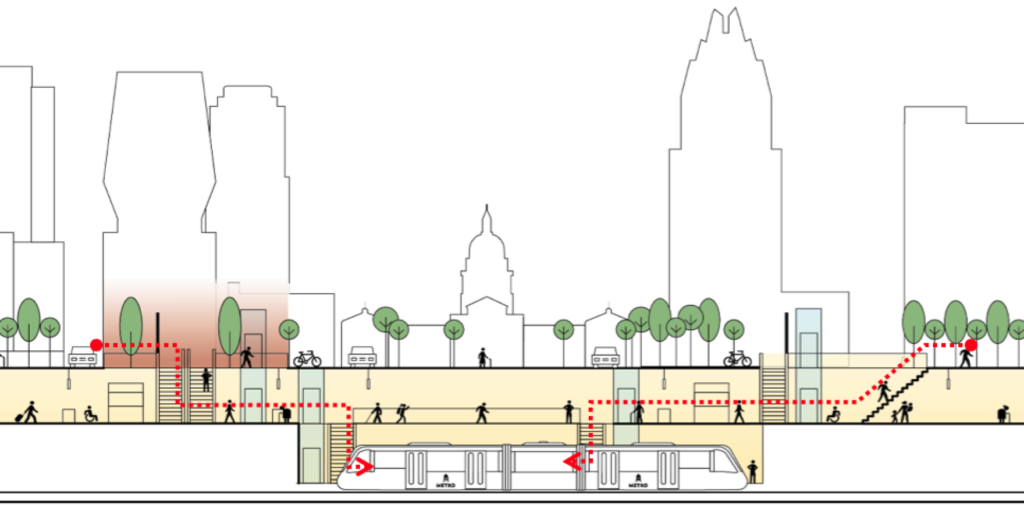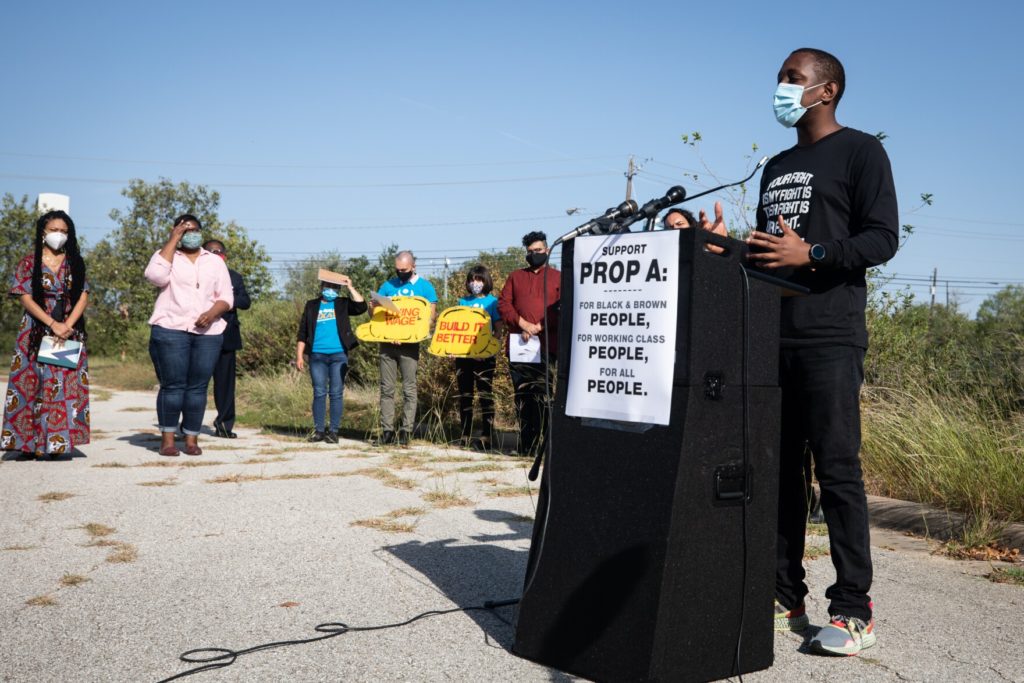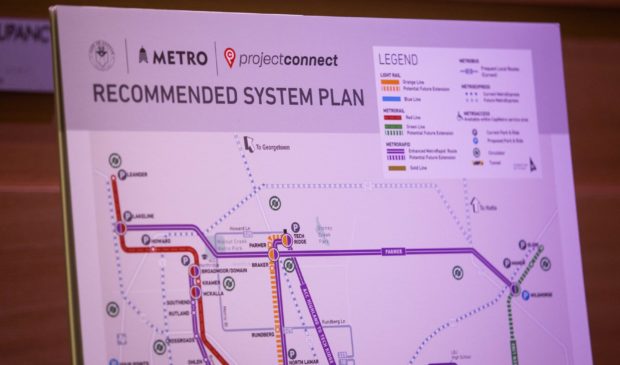Leaders to cement Austin’s multibillion-dollar transit rollout amid concerns from local advocates
Friday, October 29, 2021 by
Nathan Bernier, KUT Almost one year after Austin voters authorized the $7.1 billion expansion of public transit known as Project Connect, three layers of local government are scheduled today to finalize details of how the massive buildout of transportation infrastructure should be developed.
The formalization of roles and responsibilities, described in bureaucratic terms as a joint powers agreement, or JPA, comes as advocates for people of color and low-income construction workers express concerns over who will benefit from the project and how it will be overseen.
A group of elected and appointed officials who direct Capital Metropolitan Transportation Authority, the city of Austin and the Austin Transit Partnership – a local government corporation created to establish independent oversight of Project Connect – will convene at the Austin Convention Center this morning to work out differences over the JPA and vote on whether to adopt it.
In November 2020, Austin voters agreed to a tax increase of 8.75 cents per $100 of property value to help finance two light-rail lines, a downtown transit tunnel, expanded bus service, a new regional rail line, park-and-rides, three commuter bus routes and other components of Project Connect. The plan includes $300 million to help people who could be displaced from their neighborhoods by the higher property values that tend to follow large investments in public transit.

Rendering by Austin Transit Partnership. Transit planners envision a three-level underground light-rail system downtown.
But a coalition of local advocacy groups has concerns about the JPA. The ATX Mobility Coalition wants a more equitable transit system and independent third-party monitoring of construction sites, and for ATP to be more independent from Capital Metro.
The coalition’s members are the Austin Area Urban League, the Austin Justice Coalition, People United for Mobility Action, Planning Our Communities and Workers Defense Action Fund.

Photo by Michael Minasi/KUT. Austin Justice Coalition Executive Director Chas Moore speaks in support of Project Connect weeks before the November 2020 vote. The group is now seeking changes to the JPA, saying it “fails to meet the standards that our communities have set.”
“We’re one year into (Project Connect) now, and there are some very, very worrying tendencies,” said Joao Paulo Connolly, organizing director for the Austin Justice Coalition, a racial justice group.
Among the coalition’s concerns are what members describe as ATP’s overlap with Capital Metro. In the campaign for Project Connect, voters were told the partnership would be created to ensure that the expenditure of vast amounts of tax dollars would remain independent and transparent. ATP’s founding documents say the local government corporation should implement Project Connect “in a manner independent of the city or Capital Metro.”
Austin Transit Partnership is currently led by by the same person in charge of Capital Metro. The cost of Randy Clarke’s base salary of $327,411 and benefits is split between ATP and Capital Metro. Clarke is also eligible to receive performance and retention bonuses. Some Capital Metro employees have been hired by ATP to work on Project Connect.
“It’s even more difficult to find a traceable boundary between the two entities,” Connolly said. He said he’s worried that standard bus service catering to transit-dependent riders, who tend to have lower incomes and are more likely to be people of color, is competing for attention with the “sexy” creation of brand new services.
Capital Metro says ATP is accountable to the community and has independence on contracting and other financial decisions.
“ATP and CapMetro must be inextricably linked in order to seamlessly deliver both construction and operation of the new system in partnership,” a statement from the agency said. “In addition, Capital Metro serves as the designated recipient of federal transit funds for the Central Texas region and will be accountable for the federal funding sought for the program and utilized to build the program.”

Photo by Michael Minasi/KUT. Randy Clarke leads Capital Metro and the Austin Transit Partnership.
The ATX Mobility Coalition is also concerned the JPA does not include language guaranteeing third-party independent monitors would inspect construction sites and ensure safety protocols are being followed and subcontractors are getting paid.
The labor group Workers Defense Project has been arguing for such monitoring, saying it was promised to voters as a selling point of Project Connect. Austin City Council adopted a resolution before the November 2020 vote laying out those commitments in a “contract with the voters.”
“Texas is by far the most dangerous state to be a construction worker. It’s really a nightmare,” said Jessica Wolff with Workers Defense. “We’re talking about a project that is going to impact thousands of construction workers.”
The contract with the voters called for ATP to participate in the “Better Builder Program or a similar program with … on-site monitoring independent of construction companies and their affiliates.” The Better Builder Program was developed by Workers Defense and includes a provision that certified independent monitors be allowed to visit construction sites and speak directly with workers about safety and legal compliance.
Capital Metro has said its own staff will monitor construction sites and have the power to shut them down if safety violations are discovered.

Photo by Gabriel C. Pérez/KUT. Crews work at the construction site for an updated downtown MetroRail station that opened last year next to the Austin Convention Center.
“Cap Metro is not a private developer,” Clarke said at a board meeting last week. “We probably have the deepest level of safety of any component you will ever see in the Central Texas area.”
The JPA includes some worker protections not required by law in Texas, such as compensation for employees injured on the job and a minimum wage of $15, although many workers will earn more.
Wolff says community organizations that advocated for Project Connect ahead of last year’s referendum understood the “Better Builder Program or a similar program” language to include independent monitors, which she says are a crucial component of the program.
“I think it’s incredibly frustrating,” Wolff said. “We think that what they’re saying they’re doing is actually a divergence from what was promised.”
The joint meeting on the JPA is scheduled to start at 10 a.m. You can attend in person or watch on the city’s TV station, ATXN.
This story was produced as part of the Austin Monitor’s reporting partnership with KUT.
The Austin Monitor’s work is made possible by donations from the community. Though our reporting covers donors from time to time, we are careful to keep business and editorial efforts separate while maintaining transparency. A complete list of donors is available here, and our code of ethics is explained here.
You're a community leader
And we’re honored you look to us for serious, in-depth news. You know a strong community needs local and dedicated watchdog reporting. We’re here for you and that won’t change. Now will you take the powerful next step and support our nonprofit news organization?







